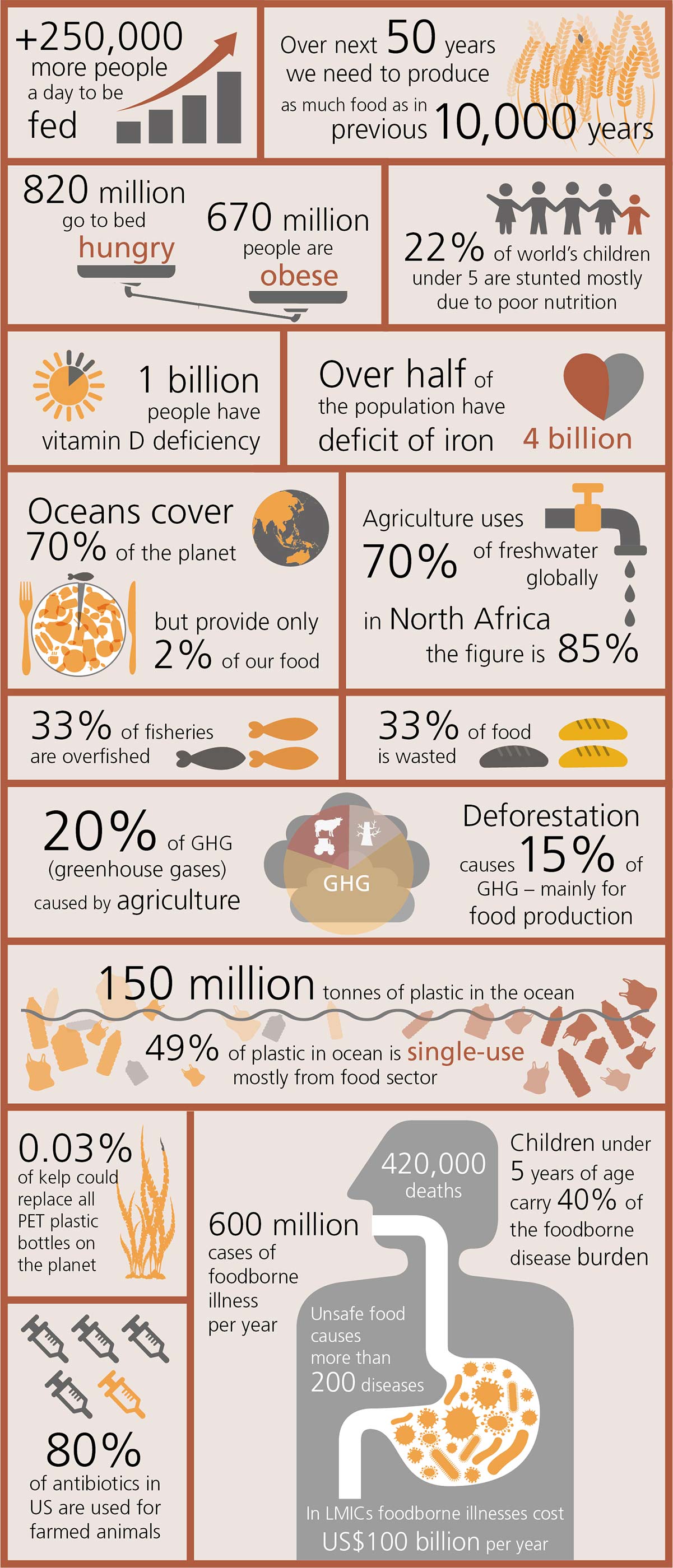
Download the Foresight review of food safety
Suggested citation
Doumeizel, V (2019) Foresight review of food safety: feeding the world safely and sustainably [online] Lloyd’s Register Foundation. Available at: https://www.lrfoundation.org.uk/en/publications
An estimated 600 million people, almost 1 in 10 people in the world, fall ill as a result of eating contaminated food and 420,000 die every year. In 2004, 160 countries voted at the United Nations to make food – safe food – a human right rather than a commodity, but risks to safety continue with many challenges putting strains on supply chains. The world is in the midst of a nutritional transition, facing over-nutrition in some regions and under-nutrition in others. With the global population expected to exceed nine billion by 2050, pressures have been placed on existing food systems and this has implications for food safety. Foodborne illnesses, from E. coli to listeria, threaten lives and everyone – consumers, companies and governments – has an important role to play in improving the status quo.
 Read more in our Foresight review of food safety
Read more in our Foresight review of food safety
The cost of unsafe food is high. The United States Department of Agriculture (USDA) estimates that foodborne illnesses cost the United States (US) at least $15.6 billion annually in lost productivity and medical care. There are environmental and social costs to food production too. The global food production system is one of the biggest contributors to greenhouse gas emissions. People today must consider alternative energy and food sources to limit the depletion of natural resources tomorrow.
We know we must take action on food safety, but many challenges stand in our way. Complex supply chains open up risks to food fraud, and a lack of traceability frustrates consumers’ abilities to understand the authenticity of what they are buying. Keeping food safe can harm the environment: plastic packaging is now an urgent global concern and food cold chains while an important part of food safety, have a negative impact on energy consumption and sustainability. At a time when food safety needs a funding boost, global research and innovation investment in food is low relative to other industries.
The fast-growing demand for food puts an enormous strain on the food production system and natural resources. If the current global population were to consume the same amount per head of meat as Europe, five planets covered with grazing land – ocean included – would be needed. The future food safety system must be sustainable and take into account this growing demand. At the same time, it must also take into account food loss and waste and address the lack of efficiency. Underlying these challenges is a need for education and training about food safety. From consumers, to companies, to governments, people need more evidence-based information in order to make informed decisions about the food they eat.
But solutions are at hand. Technology can play an important part in addressing these challenges. In the life sciences, new ways of producing proteins - lab meat, insects, seafood - can help improve not only traceability but also sustainability; aquaculture or aquafarming is the fastest-growing animal food-producing sector in the world. Urban farming and 3D-printed food help in the production of local, traceable food. New techniques in DNA verification and next-generation sequencing are opening up possibilities for genetically modifying food for greater safety. The microbiome – a community of beneficial microorganisms such as bacteria, fungi and viruses that inhabit environments including the human body – could one day become our frontline in food safety. And stable isotope technology gives us a way to ‘fingerprint’ food and help prevent fraud.
Data science and life science are about to converge to shape a new model for food safety. Big data and predictive analytics can aggregate and analyse immense volumes of information through complex algorithms to anticipate risks or critical events in the food supply chain before they happen. The internet of things will help improve the efficiency and productivity of factories and improve traceability. Agricultural drones and satellites can help identify and warn against crop pests. Blockchain – a technology that combines the openness of the internet with the security of cryptography to give a faster, safer way to verify information and establish trust – promises to revolutionise traceability in the food supply chain. It can help to tackle food fraud and deliver the information that consumers need about the food they consume.
Social evolutions are also changing the face of food safety. A new generation of consumers is driving a food revolution. These trend setters have a new set of values: they want food that is healthy but, importantly, they also want food that is sustainable and free from animal abuse, genetically modified organisms (GMOs) and modern slavery.
Following the Wikipedia and OpenStreetMap (the free wiki world map) examples, open food databases driven by citizens are gaining increasing momentum and are a big issue for food brands. Vegan, vegetarian and organic consumption are growing fast and now represent more of an ideology or lifestyle than just a diet.
The Foresight review recommends Lloyd's Register Foundation focuses investment in three core areas:
- Education and training in developed and developing countries: an interconnected approach that brings academia, citizens, governments, industry and non-governmental organisations together to act on solutions.
- Traceability in the food supply chain and development of a broad range of technologies to connect the steps and make food more traceable and, therefore, safer for consumers.
- Delivering an ocean of food: investing in aquaculture and seafood production for greater food safety and sustainability, focusing on improving current practices, and expanding and upscaling for the future.